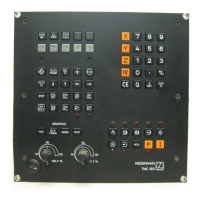CLP Processor system:
- Primarily on the CLP processor board which is common to
the TNC 155 CLP/Graphics board.
- Operating system is contained in EPROM IC-P2 -30.1-.
- The main task is the calculation of the instantaneously
intended values of the analog output voltages dependent on:
.the instantaneous actual positions
.the programmed intended position
.the distance of the intended position
(influence on deceleration ramp)
.the programmed feed rate
.the fast traverse rates determined per machine parameter
.the settings of the override and feed potentiometer
The calculating speed requires a wait-free RAM -30.2--
- The measuring system signals are processed on the analog
board. These signals are amplified at first -40.1- and
then subdivided -4O- by delaying (phase shifted) and
combining them differently. The subdivided 0 degree,
90 degrees and RI signals are then led to the gate arrays
-32-
of the CLP processor board. The gate arrays are
especially developed LSI circuits consisting of different
gates and counters in which the direction of the movement
and the number of pulses are calculated. This information
can then be scanned by CLP processor -3O- to ascertain
the actual values of the axes.
- The symmetry, the on-to-off ratio and the amplitude of the
system signals are constantly controlled by a supervision
circuit -4O-.
SERVICE MANUAL TNC 151/155
Page 52
Section 4.1
- The signals from the handwheel (if present) are shaped via
the functional block -43- and are also processed by the CLP
pr.JCeSSOr.
- If the distance between the control and measuring system is
more than 2Om. an EXE has to be interposed. The measuring
signals are thus already amplified, subdivided, evaluated,
supervised and converted in TTL signals. An "R" version of
the control is used accordingly (e.g. TNC 151 BR) equipped
with a combined EXE connection for X-, Y-, and Z-axis and
an analog board TTL. The input amplifiers and the wiring
for the signal subdivision are replaced with line receivers
-4O- on this analog board whose outputs are directly con-
nected to the gate arrays
-32-
on the CLP processor board.
The supervision signal of the EXE is also buffered -4O- and
transferred to the CLP processor board. The signals of the
handwheel are likewise processed -43- as on the "normal"
(sine) analog board.
If instead of linear position transducers incremental enco-
ders are used to ascertain actual values a reference pulse
appears once per revolution. Since only one reference pulse
is to be evaluated all other reference pulses of the axes
X, Y, Z, IV are inhibited on the analog board -4O-. The
signal lines are connected with the analog board via the PLC
I/O board and the PLC interface board. The level conversion
MOS/TTL as well as the galvanic decoupling is carried out
on the PK interface boards via -51- and -5O-.

